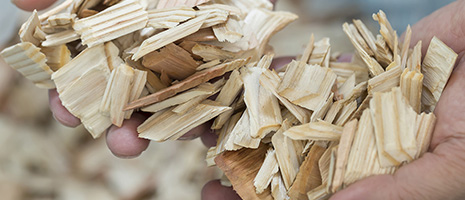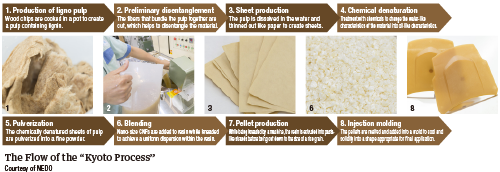Home > Highlighting JAPAN > Highlighting Japan September 2016 > Science & Technology
Highlighting JAPAN

Knock on Wood
A Japanese research group has developed a highly efficient manufacturing technology for the production of “cellulose nanofibers,” a strong, light and as such environmentally friendly material with multiple applications made from wood.
Each cell found in wood is surrounded by a cell wall. This cell wall has a similar structure to that of reinforced concrete. In this analogy, the macromolecule called lignin represents the concrete, while the cellulose corresponds to the reinforcement. Cellulose nanofibers (CNFs) are produced by unraveling and reconstituting the cellulose. The majority of the components found in cell walls are cellulose, which means that there is an abundance of cellulose contained in wood.
In recent years, competition has intensified in the development of CNF manufacturing technology. The main reason for this is the strength that CNFs offer. They weigh only one fifth the weight of steel, and yet are about five times stronger. It is possible to produce strong, yet light composite materials by simply combining CNFs with plastic resins.
Numerous types of chemicals are used in cars and home appliances, such as plastic and synthetic fibers. The main ingredient of chemicals is petroleum, and this accounts for about 23 percent of the petroleum consumption in Japan. Replacing these chemicals with composite materials reinforced with CNFs would help decrease petroleum consumption, while at the same time creating opportunities to lower CO2 emissions by reducing the weight of products.
For example in cars, components made of plastic resins are said to account for about 9 percent (about 110 kg) of the weight of the car body. By replacing these resins with CNF-reinforced resins, the weight can be reduced by about 20 kg, and a significant improvement can be expected in fuel efficiency.
CNFs hold great promise for Japanese industries because they allow them to utilize one of the natural resources found in Japan: wood. While Japan depends on imports from overseas for many resources, wood is one of the few resources that can be mass-produced in Japan. Forests account for about 70 percent of the land of Japan. This percentage is one of the highest among developed countries.
In light of these factors, there is growing momentum throughout Japan to promote the research and development of CNFs. The “Japan Revitalization Strategy 2016” approved by the cabinet in June this year clearly states the need for the research and development of CNFs ahead of international standardization and commercialization. The Ministry of Economy, Trade and Industry has also set a goal of “mass-producing CNFs by 2020, and achieving growth of the CNF-associated market to one trillion-yen by 2030.”
However, the manufacturing cost remains high, and resins reinforced with CNFs currently cost 10,000 yen per kg to produce. This is because of the numerous processes involved in the manufacturing of CNFs, which must be performed before they are combined with plastic resins. One of the research tasks involves identifying how to manufacture high-quality CNFs in the most efficient fashion.
In March this year, a new manufacturing method known as the Kyoto Process was successfully developed by a group taking part in a project carried out at the New Energy and Industrial Technology Development Organization (NEDO). This group was brought together through collaboration between industry and academia, and was chiefly driven by members from Kyoto University. In addition to making manufacturing costs ten times lower than conventional methods, they also succeeded in creating an integrated manufacturing method for making composite materials with CNF-reinforced resins from wood chips, the main ingredient.
One of the ideas employed by the Kyoto Process to reduce costs was chemical denaturation. In conventional methods, the fibers of the main ingredient, pulp, need to be unraveled into nanometer-size (nanoized) fibers before applying a type of chemical processing that enables them to be easily combined with plastic resins.
As Kenichi Sasaki from the NEDO Material Technology and Nanotechnology Department explains, “Many types of resins share properties that are similar to oil. On the other hand, CNFs have a great affinity for water. If you try to combine something that has an oily property with something that has a watery property, they simply won’t blend; just like salad dressing.”
In order to solve this problem, Sasaki’s research team chemically denatured CNFs through chemical processing so that they could gain properties similar to those of oil. This approach also helped to simplify the process. They created nano-sized fibers after the pulp was chemically denatured, and then combined them with resins. This was done because the latter process would become complicated if they created nano-sized fibers before chemical denaturation.
One of the characteristics found in CNFs manufactured with the Kyoto Process is that they are ligno CNFs which contain the right amount of lignin. Researchers around the world have been attempting to manufacture lignin-free CNFs, because they believed lignin was unnecessary. However, the removal of lignin led to problems such as damage to cellulose and insufficient heat resistance. The Kyoto Process intentionally leaves lignin in so that CNFs with excellent heat resistance can be manufactured.
“We will provide companies and public institutions with a sample of CNFs manufactured under the Kyoto Process, and work to apply their feedback as we take the next step towards practical application,” says Sasaki.

© 2009 Cabinet Office, Government of Japan






